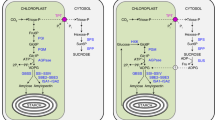Abstract
The metabolism of wild-type Arabidopsis thaliana L. and its mutant TC265 were compared in order to reveal the role of the chloroplast glucose transporter. Plants were grown in a 12-h photoperiod. From 20 to 40 days after germination, starch per gram fresh weight of shoot in the mutant was four times that in the wild type. The extent of this difference did not alter during this period. Stereological analysis showed that the chloroplasts in the mutant were larger than those in the wild type; the thylakoids appeared to be distorted by the high starch content. [U-14C]Glucose and [U-14C]glycerol were supplied, separately, to excised leaves in the dark. [U-14C]Glucose was a good precursor of sucrose in the wild type and mutant; [U-14C]glycerol was a poor precursor of sucrose in both. The distribution of 14C in the wild type was used to calculate that the net flux was from hexose monophosphates to triose phosphates, not vice versa. During the first 4 h of the night the sugar content (75% sucrose, 20% glucose) of the leaves of the mutant dropped sharply, and at all times during the night it was less than that of the wild-type leaves. This drop in sugar coincided with a decrease in the rate of respiration. The growth rate of the mutant was less than that of the wild type. Addition of sucrose restored the rate of respiration at night and increased the rate of growth. It is argued that a major function of the glucose transporter in Arabidopsis chloroplasts is export of the products of starch breakdown that are destined for sucrose synthesis at night.
Similar content being viewed by others
References
Bergmeyer, H.-U. (1984) Methods of enzymatic analysis, vol. VI: Metabolites 1: Carbohydrates, Verlag Chemie, Weinheim, Germany
Bryce, J.H., ap Rees, T. (1985) Effects of sucrose on the rate of respiration of the roots of Pisum sativum. J. Plant Physiol. 120, 363–367
Caspar, T., Lin, T.-P., Monroe, J., Benbow, L., Preiss, J., Somerville, C.R. (1991) Mutants of Arabidopsis with altered regulation of starch degradation. Plant Physiol. 95, 1181–1188
Harley, J.L., Beevers, H. (1963) Acetate utilization by maize roots. Plant Physiol. 38, 117–123
Haughn, G.W., Somerville, C.R. (1986) Sulfonylurea-resistant mutants of Arabidopsis thaliana. Mol. Gen. Genet. 204, 430–434
Hill, S.A., ap Rees, T. (1994) Fluxes of carbohydrate metabolism in ripening bananas. Planta 192, 52–60
Morrell, S., ap Rees, T. (1986) Control of the hexose content of potato tubers. Phytochemistry 25, 1073–1076
Pollock, C.J., ap Rees, T. (1975) Effect of cold on glucose metabolism by callus and tubers of Solanum tuberosum. Phytochemistry 14, 1903–1906
Rébeillé, F., Bligny, R., Martin, J.-B., Douce, R. (1985) Effect of sucrose starvation on sycamore (Acer pseudoplatanus) cell carbohydrate and Pi status. Biochem. J. 226, 679–684
Reynolds, E.S. (1963) The use of lead citrate at high pH as an electron-opaque stain in electron microscopy. J. Cell Biol. 17, 208–213
Spurr, A.R. (1969) A low-viscosity epoxy resin embedding medium for electron microscopy. J. Ultrastruct. Res. 26, 31–43
Steer, M.W. (1981) Understanding cell structure, Cambridge University Press, Cambridge, UK
Stitt, M., ap Rees, T.. (1978) Pathways of carbohydrate oxidation in leaves of Pisum sativum and Triticum aestivum. Phytochemistry 17, 1251–1256
Trethewey, R.N., ap Rees, T. (1994) A mutant of Arabidopsis lacking the ability to transport glucose across the chloroplast envelope. Biochem. J. 301, 449–454
Author information
Authors and Affiliations
Additional information
We thank Professor C.R. Somerville for his generous gift of seed of the Arabidopsis mutant TC265. We are also grateful to Mr B. Chapman for assistance with the preparation of the sections for electron microscopy. R.N.T. thanks the Science and Engineering Research Council for a studentship.
Rights and permissions
About this article
Cite this article
Trethewey, R.N., ap Rees, T. The role of the hexose transporter in the chloroplasts of Arabidopsis thaliana L.. Planta 195, 168–174 (1994). https://doi.org/10.1007/BF00199675
Received:
Accepted:
Issue Date:
DOI: https://doi.org/10.1007/BF00199675




